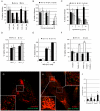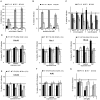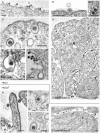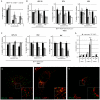Entry of human papillomavirus type 16 by actin-dependent, clathrin- and lipid raft-independent endocytosis
- PMID: 22536154
- PMCID: PMC3334892
- DOI: 10.1371/journal.ppat.1002657
Entry of human papillomavirus type 16 by actin-dependent, clathrin- and lipid raft-independent endocytosis
Abstract
Infectious endocytosis of incoming human papillomavirus type 16 (HPV-16), the main etiological agent of cervical cancer, is poorly characterized in terms of cellular requirements and pathways. Conflicting reports attribute HPV-16 entry to clathrin-dependent and -independent mechanisms. To comprehensively describe the cell biological features of HPV-16 entry into human epithelial cells, we compared HPV-16 pseudovirion (PsV) infection in the context of cell perturbations (drug inhibition, siRNA silencing, overexpression of dominant mutants) to five other viruses (influenza A virus, Semliki Forest virus, simian virus 40, vesicular stomatitis virus, and vaccinia virus) with defined endocytic requirements. Our analysis included infection data, i.e. GFP expression after plasmid delivery by HPV-16 PsV, and endocytosis assays in combination with electron, immunofluorescence, and video microscopy. The results indicated that HPV-16 entry into HeLa and HaCaT cells was clathrin-, caveolin-, cholesterol- and dynamin-independent. The virus made use of a potentially novel ligand-induced endocytic pathway related to macropinocytosis. This pathway was distinct from classical macropinocytosis in regards to vesicle size, cholesterol-sensitivity, and GTPase requirements, but similar in respect to the need for tyrosine kinase signaling, actin dynamics, Na⁺/H⁺ exchangers, PAK-1 and PKC. After internalization the virus was transported to late endosomes and/or endolysosomes, and activated through exposure to low pH.
Conflict of interest statement
The authors have declared that no competing interests exist.
Figures










References
-
- Sapp M, Day PM. Structure, attachment and entry of polyoma- and papillomaviruses. Virology. 2009;384:400–409. - PubMed
-
- Roberts JN, Buck CB, Thompson CD, Kines R, Bernardo M, et al. Genital transmission of HPV in a mouse model is potentiated by nonoxynol-9 and inhibited by carrageenan. Nat Med. 2007;13:857–861. - PubMed
Publication types
MeSH terms
Substances
LinkOut - more resources
Full Text Sources
Research Materials

